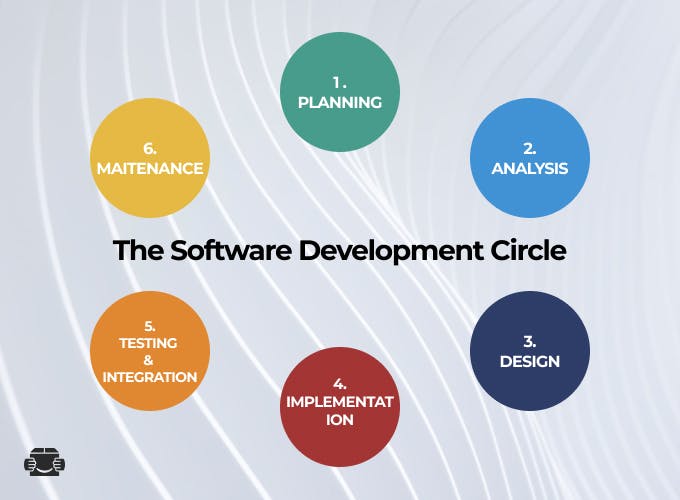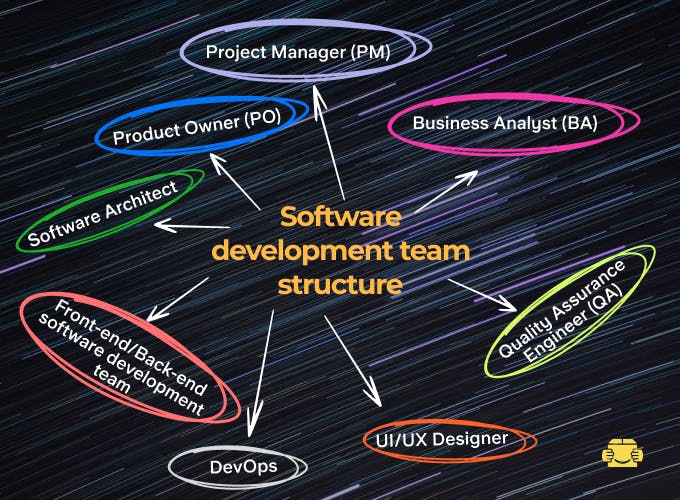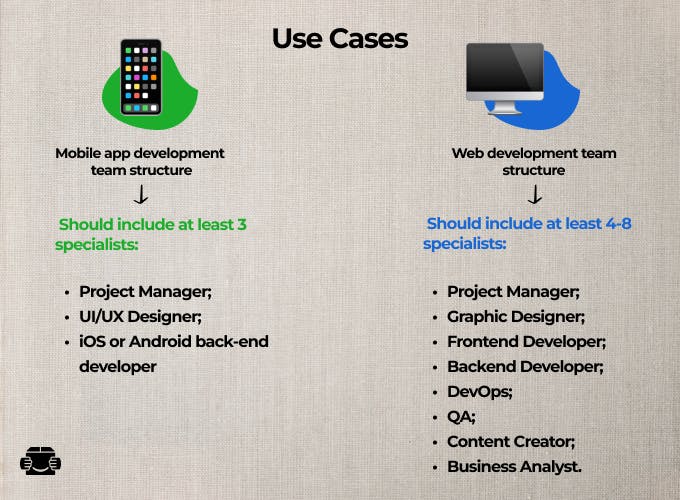Software development team: structures, approaches, and characteristics
A successful software development team consists of 8 people. Who are they and what are they doing?
Maria Shapovalova
June 01, 2022
13 min read

Let’s start with the software development team definition. Should be pretty obvious, right?
A professional collective engaged in designing, building, deployment, and maintenance of IT software is a software development team.
There’s an active debate on the web concerning the most efficient software development team model: the fastest, most reliable, cheap, and effective in regard to the product quality.
Software development team structure
The underlying framework defines software development team structure.
The fans of Agile Manifesto claim that Agile is not a methodology; rather an approach. So, which approach do you choose and what criteria do you consider? The most common ones are traditional, Agile, and Scrum. As you look out for a dedicated software development team, take the difference between them into account.
The nature of the product is the central criterion when it comes to deciding on the project management framework. Naturally, one cannot discard the budget limitations, personal preferences, the established cooperation model inside an in-house team, and so on. Ultimately, you aim for convenience and efficiency. Here is how various frameworks ensure that.
Agile vs traditional software development team
Documented about 50 years ago, the waterfall model is notable for the strict order of steps in development. Once the planning phase is finished, the product requirements are set in stone. Who would want such clumsiness in development as of 2022? Hardware and firmware developers in particular.
Embedded systems strictly rely on hardware, so it is important to develop software for it only once and do it right. The CI/CD paradigm just does not work for embedded systems, and the software engineer team has to consider that.
The Waterfall model is associated with the notion of Software Development Life Cycle (SDLC). They are not identical (and the variations of SDLC exist), but they share the same principle of immutability of rules, documentation, and development steps.

Some developers refer the term SDLC to just any development framework in general, but let us just stick to comparing it with Waterfall.
The SDLC model software team will shine tackling the following tasks:
Hardware and firmware design.
Small software projects with predictable risks and budget.
Niche-specific software that is meant to run for decades without updates.
Agile development team is a lot more flexible, which gives away its drawbacks right away: when you aim for stability, flexibility is unnecessary. Alterations to product design or architecture can be introduced at any stage. This approach is also called “incremental development” and every new product version, that is going to be deployed, is called an increment.
Being open to change is fundamental in Agile or similar approaches. It is deadly for material object production workflows, such as hardware, or for low-level programs that are inseparable from hardware. The overhead costs and production delays will gravely harm hardware/firmware products if a crucial change must be introduced in the middle of development.
The Waterfall model must have a single CTO, Chief Technical Officer. On the other hand, an Agile dev team shares responsibility for a product and defines its course of development to a great extent.
Basic software development team structure
The Scrum software development model establishes three obligatory roles in every team: Product Owner (PO), Scrum Master or Project Manager (PM), and the Development Team.
Unlike the SDLC roles (that are straightforward and fixed), the Agile roles assigned to each participant can overlap. For example:
A solo developer represents all of the roles simultaneously.
If an entrepreneur orders mobile app development services from a small team, one of the team members may carry the role of PM.
If a given company works on their in-house product, the team itself carries the role of PO, suggesting product improvements, pointing out the weak spots, and establishing the general development direction. In other words, they are the early access users.
The basis of Scrum is Sprint, a period of time during which the work on the product is performed. A new version of the product must be produced by the end of each Sprint. Time limitations for each sprint are an obligatory feature of Scrum and have the same duration throughout the life of the product.
The optimal number of software team members is 7 (+/-2), following the famous “two-pizza” rule by Jeff Bezos. But the total number of devs in an organization is not really limited.
As teams scale, the two-pizza rule still applies to departments or office rooms.

The most important software development team roles and responsibilities are as follows:
Business Analyst (BA)
The main responsibility of BA is to scout the market, establish communication between a PO and a software development team, and research into the product. The market and target audience research, competitor analysis and marketing plan are also within their remit. Often, the BA duties are taken up by POs, distributed among developers, etc.
They are flexible generalists and are extremely useful in cases when there is a lack of clarity about the product, the users’ expectations do not coincide with the vision of the team, or if multiple stakeholders have conflicting goals and visions.
Project Manager (PM)
It is ironic that PMs carry the responsibility for the outcomes of cooperation between the PO and the dev team but do not immediately take part in development themselves. Their primary mission is managing software development teams.
The scope of PM’s responsibilities is similar to the BAs, except that they do not market and product research:
team management;
regular communication with the product owner;
cost baseline calculation;
documentation;
overlooking the team’s capabilities and limitations.
Product Owner (PO)
A PO is a project’s primary stakeholder: an entrepreneur, investor, or a CEO of a given team. Their full engagement in the process is vital for successful product development. Product Owner’s responsibilities include overseeing the product development in general, suggesting the marketing strategy, and shaping the vision of the final product.
Software Architect
A Software Architect is responsible for product's functionality, performance, comprehensibility, and security. This person makes decisions concerning design choices, technological stack, and technical standards. Usually, their particular function depends on the project size and needs.
Front-end/Back-end software development team
Focusing correspondingly on programming the visual appearance of a website and its controls (UI/UX), and the software that runs on the server, Front-end and Back-end developers together deliver a wholesome piece of software: convenient and functional.
DevOps
The range of tasks that they do in different organizations wildly varies. They include security management, automated testing of cross-platform solutions, automation of repetitive tasks in other departments, developing a shared workspace software development teams, and so on.
Quality Assurance Engineer (QA)
QA engineers are focused on testing all possible use cases of a product and its behavior
in various states, including the possible attempts of misuse.
The quality control can be either manual or automated: certain aspects of user experience cannot be tested by machines, so both Manual QA and QA Automation Engineer teams might be necessary.
They also escalate user top user queries to developers, and introduce minor changes to the code whenever they can. They are responsible for the product’s safety and sustainability.
UI/UX Designer
Unlike the rest of the IT team, UI/UX designers are rather artists than engineers. Their responsibility is to simplify the user journey and provide intuitively understandable controls and aesthetic looks throughout the interface.
Why do we need a BA and QA in SDLC process?
Both BA and QA perform important functions. While a Business Analyst approves the initial requirements, identifies the gaps, and points out the best marketing decisions, QA department fail-tests software on every stage of production, helping to avoid non-obvious flaws.
Use cases
To date, software development specialists of all kinds are in high demand because they provide solutions to every business niche in existence.
Team structures may vary depending on certain client's needs, aims, budget, methodology, and features of the product being developed. There is no single “right” way: different problems and tasks require different approaches.
Not every company can afford an in-house team, which brings up the necessity to hire a development team: an offshore or nearshore one.

Mobile app development team structure
Mobile apps are on the peak of their popularity: portability and productivity of mobile apps bring ever more IT software developers into the niche.
Developing an app for each of the existing operating systems requires different skills in programming languages and frameworks.
Mobile app developers may prefer cross-platform development frameworks. It fits visually simple, lightweight apps. The disparities between the app’s look and productivity across platforms become more significant according to the product’s scale.
The smallest mobile app development team structure should include at least 3 specialists:
Project Manager;
UI/UX Designer;
iOS or Android back-end developer.
One could cut it down to two if they have a full-stack developer on their team instead of a front-end/back-end duo.
The more convoluted the product is, the more roles in software development it will require, such as QA or DevOps specialists, creative writers, graphic designers, etc.
Web development team structure
Web-based applications run either on in-house servers or in the cloud, designed to process significant workloads.
To create such a product, an entrepreneur may hire a software development team consisting of at least a single full stack developer. It goes without saying that a generalist full-stack dev will have to be proficient with both back-end and front-end technologies. We will get to the pros and cons of generalist and specialist teams in a moment.
There also has to be a PM to handle all the communication.
More software team members will develop any project faster, safer, and even cheaper, considering the whole investment-to-profit ratio.
A professional web application development team consists of 4 to 8 roles. Front end and back end developers, Content Manager, and Project Manager are more than enough to get a simple online store up and running, for example.
A Graphic Designer would add unique looks to the website. DevOps would take care of seamless continuous deployment. QA team would test the looks and functions in different web browsers. A BA would provide insights concerning new marketing platforms, product improvements, partnerships, competitors, etc.
The payment model choice
The two payment models that basically dominate the job market are hourly and per-project. The safe way to choice an appropriate model for a given project is to stick to the following criteria:
Hourly rate works best for flexible development frameworks, unpredictable markets, and undefined product specification. Customers risk to end up with poorly developed final product in this case.
Fixed prices put the service providing software development company at more risk: should they fail to deliver the product that perfectly complies to the initial requirements, they will have to compensate the time loss and other resources spent by the customer.
The guide to mitigating the risks is straightforward. Per-hour projects must be assigned to specialists with relevant experience, favorable testimonials, and similar finished projects.
Responsible developers finish simple tasks faster just for the sake of personal challenge. It is hard to hide one’s talent; these developers will radiate confidence and boast positive client reviews.
As for the per-project payments—which are safer for a client by default—the latter must obligatorily put all the effort into designing the product specification in such a way that there is possible it would require significant alterations. Alterations entail the prolongation of deadlines and project costs.
There is a golden path in the payment model choice. Define realistic short-term goals in development and remunerate each one separately. It would be best if a single team carried out the development from start to finish, yet, if a client wants to switch the team for any reason, they can comfortably do so after achieving a certain project’s milestone.
Software development team composition
It depends on the project scope, features, and budget, whether the software development team members should be mostly generalists or specialists.
Generalist
The distinctive feature of the generalist teams is that each of their members understand how the product works as a whole. Such an approach ensures high role fluidity: e.g. a PM may code or fix bugs while a development team tests their solutions and documents progress.
They communicate among themselves better and are the perfect choice for simple, single-purpose projects.
Nonetheless, compared to specialists, they lack in-depth knowledge and diverse experience of a single technology.
Specialist
Unlike generalists, are not interested in cross-domain knowledge. If the roles are unambiguously defined and efficiently managed, these teams demonstrate miraculous results. Yet fracturing the product development team into isolated roles increases the communication-related risks.
Specialist teams are typically involved in large-scale projects.
Hybrid
A simple principle at the core of hybrid teams is to put generalists as heads of departments and fill the said departments with specialists.
Such a software development project team structure mitigates the weaknesses of generalist-only or specialist-only teams, but it comes at a price. Hybrid teams take more time to assemble and are usually more expensive.
Characteristics of an effective software development team structure
With no regard to its composition type, any team has to take care of the following aspects in development:
Effortless communication within the team and with the PO;
Plain team goals;
Unambiguous role distribution;
Respectful and supportive legal boundaries;
The right team hierarchy.
Who is in charge of software application development teams?
Traditional software development models make a single high-ranking authority responsible for the overall success of a given venture. It could be Tech Lead or Software Architect depending on chosen project development team structure.
There is no certain central figure in Agile teams; the responsibility and ownership is shared equally among all members. Every participant can suggest changes to a product, if appropriate. Nonetheless, Project Managers bear a larger portion of responsibility for managing software development teams.
Of course, those members who are higher on the hierarchy (e.g., a software team lead), are more liable for the overall success.
Wrapping up
Hiring a software engineer team is a common practice for modern business. It is more practical than building a software development team from scratch.
In both cases, appropriate choice of software team roles largely defines the overall team’s effectiveness.
When the budget is tight and a product must be rolled out fast, it is best to delegate development team roles and responsibilities distribution to a third-party service provider and leave the final IT team structure up to them.
FAQ
What is a good software development team?
A well-built team does not suffer from miscommunication and data siloing, has clear and consistent roles and hierarchy. It has an appropriate proportion of specialists so that no one falls behind or has to wait for the others.
How are development teams structured?
Every specialist team has a formal or informal Team Lead who, in turn, reports to a Chief Technical Officer or another C-level authority – if the team is large enough, of course. Small Agile teams have only a single Project Manager and a stack of developers.
What is development team management?
Management itself the ability to define mutual goals, ensure comfort and seamless communication within a given team; guide and organize it. It also entails responsibility for the final work result.
What is the best way to manage a software development team?
There must be a healthy balance between personal freedom and adherence to order: deadlines, objectives, general ethics, and so on. The best way to manage a team is to let every member do what they are best at, minimizing conflict and competition in the process, and supporting them at their weakest.